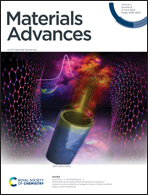Detrapping of the carriers from shallow states in a highly responsive, fast, broadband (UV-vis-NIR), self-powered SnSe/Si photodetector with asymmetric metal electrodes†
Abstract
Tin-selenide (SnSe), as an eco-friendly and low-cost semiconductor material, has exhibited great potential to detect weak signals and has wide applications in imaging and optical communication. Here, self-powered SnSe-based photodetectors (PDs) via asymmetric metal electrodes are fabricated to achieve weak light detection for broad spectral ranges from 385 to 1064 nm with high response and fast response (on/off) times. The results show that the SnSe PDs are highly sensitive in a wide spectral range from UV to NIR, even at 0 V applied bias. They exhibit an excellent responsivity (R) of 54.7 mA W−1 and detectivity (D) of 7.87 × 1010 Jones, corresponding to rise/decay times of 26/47 ms under 1064 nm illumination at 0 V applied bias, respectively. With increasing the bias, detrapping of the carriers can be seen from the shallow trap states arising from the secondary phases in the SnSe. The results suggest that SnSe-based PDs obtained from the evaporation method have great potential in developing low-cost, next-generation, and self-powered optoelectronics.



 Please wait while we load your content...
Please wait while we load your content...